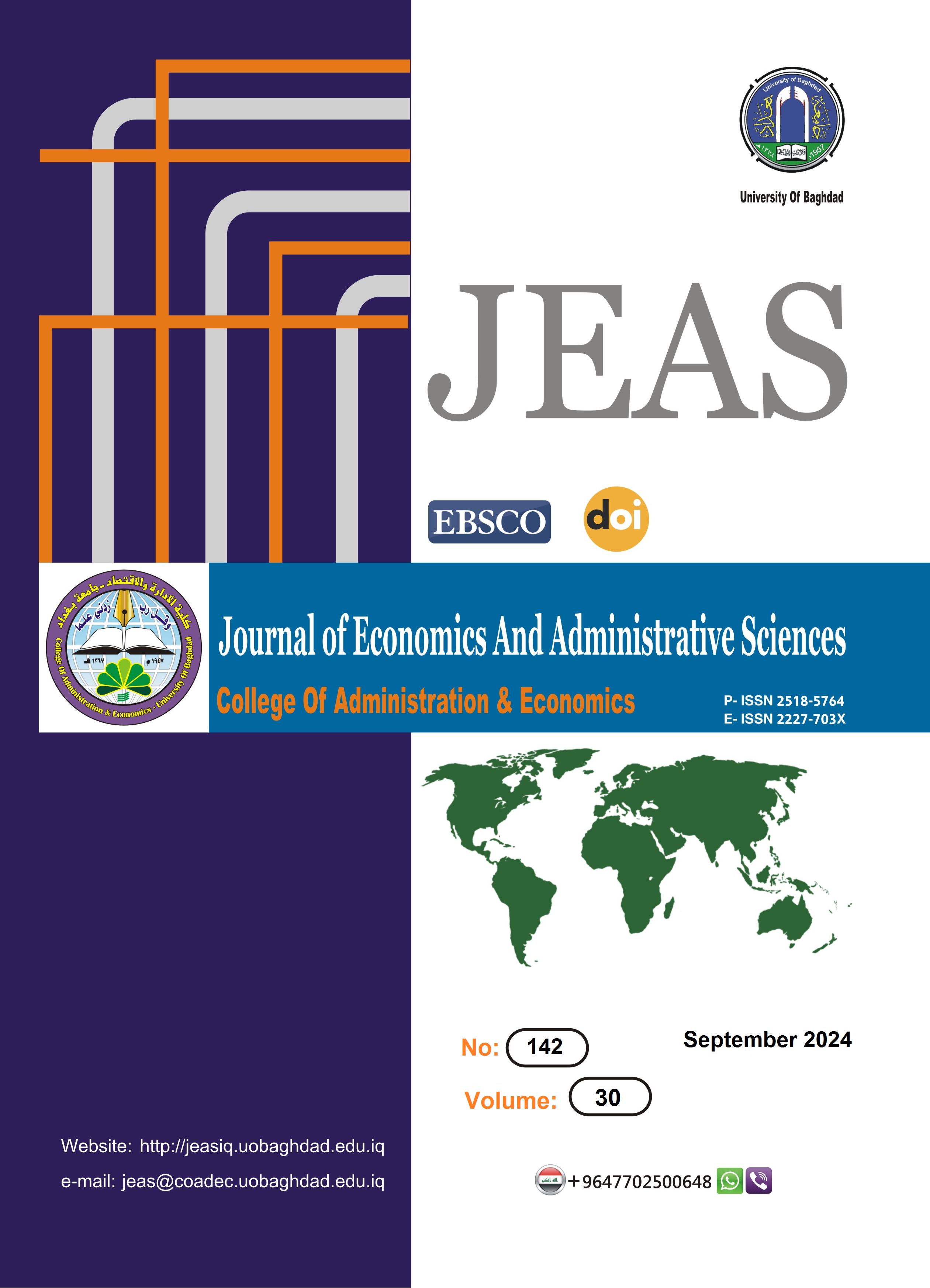Some Fuzzy Least Squares Estimators for Regression Model Using Different Kernel Functions
DOI:
https://doi.org/10.33095/7qdnc433Keywords:
Robust fuzzy regression, Fuzzy least squares method, Distance between fuzzy triangular numbers, Kernel functions, Outliers.Abstract
This paper presents a method for addressing the issue of outliers in fuzzy data. The method involves calculating a new distance between fuzzy numbers using various kernel functions, based on the fuzzy least squares method. The parameters of the fuzzy regression model were estimated in cases where the explanatory variables were non-fuzzy, the parameters were fuzzy, and the response variable was both fuzzy and an outlier. These estimators were then compared to the Fuzzy Least Squares method (FLS) using Mean Square Error (MSE) through simulations with different sample sizes (25, 50, 100, 150) and levels of outliers (0, 0.10, 0.20, 0.30). The results showed that this method, utilizing the new distance, achieved the best results in the presence of outliers.
Paper type: Research paper.
Downloads
References
References
Kareem, R. E, and Mohammed, M. J. 2023. Fuzzy Bridge Regression Model Estimating via Simulatio. Journal of Economics and Administrative Sciences. 29(136), pp. 60-69.
Shemail, A.H. and Mohammed, M.J. 2022. Semi Parametric Logistic Regression Model with the Outputs Representing Trapezoidal Intuitionistic Fuzzy Number. Journal of Economics and Administrative Sciences. 28(133), pp. 7-18.
Stanojević, B, and Stanojević, M. 2022. Quadratic least square regression in fuzzy environment. Procedia Computer Science. 214 , pp. 391-396.
Kim, H, and Jung, H. Y. 2020. Ridge fuzzy regression modelling for solving multicollinearity. Mathematics, 8(9), 1572.
al-Douri, M.S. and Hamza, R.K., 2019. Comparison of estimations methods of the entropy function to the random coefficients for two models: the general regression and swamy of the panel data. Journal of Economics and Administrative Sciences. 25(110).
Mohammed J.M, and Rashid D.H, 2007. Robust Eestimations for Fuzzy Regression. The 1st Arab Statistical Conference (SAC-1),12-13 Nov. At: Amman-Jordan.
Mohammed, M.J. and Abbas, A.F. 2017. A Comparisons between Memberships Function and Entropy Function in Fuzzy Adaptive Linear Regression. Journal of Economics and Administrative Sciences, 24(103), pp.453-476.
Kham mar, A. H., Arefi, M, and Akbari, M. G. 2020. A robust least squares Fuzzy Regression model based on kernel function. Iranian Journal of Fuzzy Systems. 17(4), pp. 105-119.
Hmood, M. Y., 2015. On Single Index Semiparametric Model. Journal of Statistical Sciences, (6), pp. 1-17.
Abbas,M,S and Mohammed, J,M. 2018. Fuzzy Nonparametric Regression Model Estimation Based on some Smoothing Techniques with Practical Application. Journal of the college of basic education, 24(101).
Farhan, Ali Mohammed 2013. Building a fuzzy multiple linear regression model for global oil prices. Master’s thesis, University of Baghdad, Iraq.
Chachi, J. 2018. A weighted least Squares Fuzzy Regression for crisp input-fuzzy output data. IEEE Transactions on Fuzzy Systems. 27(4),pp. 739-748.
Klir, G, and Yuan, B. 1995. Fuzzy sets and fuzzy logic. (Vol. 4, pp. 1-12). New Jersey: Prentice hall.
Wu, H. C. 2003. Linear Regression Analysis for Fuzzy input and output data using the extension principle. Computers and Mathematics with Applications. 45(12),pp. 1849-1859.
Mohammadi, M, Sarmad, M, and Arghami, N. R. 2021. An Extension of the Outlier Map for Visualizing the Classification Results of the Multi-Class Support Vector Machine. Malaysian Journal of Computer Science". 34(3),pp. 308-323.
Månsson, K, Kibria, B. G, Sjölander, P and Shukur, G. 2012. Improved Liu estimators for the Poisson regression model. International Journal of Statistics and Probability, 1(1), May.
Yang, M. S., and Lin, T. S. 2002. Fuzzy least-squares linear regression analysis for fuzzy input–output data. Fuzzy Sets and Systems, 126 (3), pp. 389-399.
Gunst, R.F. and Mason, R.L, 1980. Regression Analysis and its Application. Marcel Dekker Inc, New York, U.S.A, p.114.
Zimmermann, H.J Fuzzy set theory and its applications, Boston: 4th ed, Kluwer Nihoff, 2001.
Taheri,S,M.and Kelkinnama,M. Fuzzy linear regression based on least absolute deviations. Irannian Journal of Fuzzy Systems, 9 (2012), pp.121-140.
Ayden, H.H, and Rawya, I.K. 2020. Estimating robust regression using hippocampal fuzzy estimators based on ordinal functions. Economics and administration studies journal (EASJ) (formerly al-dananeer journal), 1(18).
Zeng, J, and Zhang, A. 2018 statistical analysis of fuzzy linear regression model based on different distances. International Journal of Fuzzy Logic Systems (IJFLS). 8(1/2), April.
Hesamian, G., and Akbari, M. G. 2021. A robust multiple regression model based on fuzzy random variables. Journal of Computational and Applied Mathematics, 388, 113270.
Kalnins, A., 2018. Multicollinearity: How common factors cause Type 1 errors in multivariate regression. Strategic Management Journal, 39(8), pp.2362-2385.
Barua, A., Mudunuri, L. S., and Kosheleva, O. 2013. Why trapezoidal and triangular membership functions work so well: Towards a theoretical explanation.
Published
Issue
Section
License
Copyright (c) 2024 Journal of Economics and Administrative Sciences

This work is licensed under a Creative Commons Attribution-NonCommercial-NoDerivatives 4.0 International License.
Articles submitted to the journal should not have been published before in their current or substantially similar form or be under consideration for publication with another journal. Please see JEAS originality guidelines for details. Use this in conjunction with the points below about references, before submission i.e. always attribute clearly using either indented text or quote marks as well as making use of the preferred Harvard style of formatting. Authors submitting articles for publication warrant that the work is not an infringement of any existing copyright and will indemnify the publisher against any breach of such warranty. For ease of dissemination and to ensure proper policing of use, papers and contributions become the legal copyright of the publisher unless otherwise agreed.
The editor may make use of Turtitin software for checking the originality of submissions received.


























